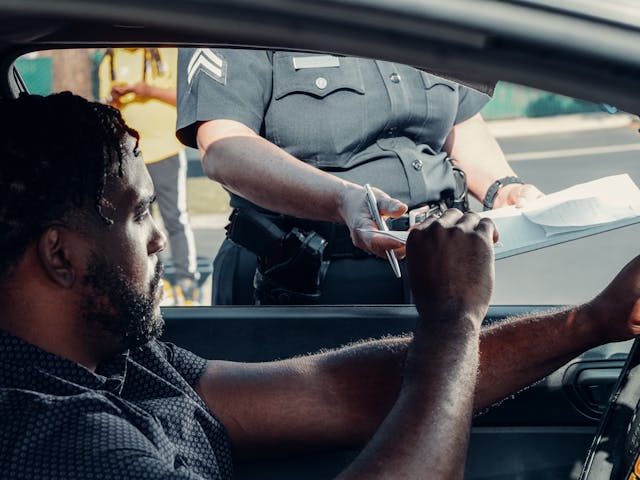April 4, 2024
Inferable Discrimination: A Landmark Decision Addresses Selective Law Enforcement
Assistant Professor, Northeastern University School of Law

“Black drivers have a problem in Richmond, Virginia.” i
In February, a federal district judge in Richmond, Virginia, concluded that Mr. Keith Moore presented sufficient evidence to prove selective enforcement of the law by the Richmond Police Department (RPD) against Black drivers. United States District Judge John A. Gibney Jr. granted Mr. Moore’s motion to dismiss the government’s indictment for illegally possessing a firearm after finding that Moore had established the discriminatory effect and purpose elements necessary to prove his claim of systemic bias. This decision illustrates an avenue for courts to overcome doctrinal barriers when specific statistical evidence of racial disparity combined with historical context permit the inference of bias.
The constitutional promise of Equal Protection prohibits racial discrimination in policing,iibut the doctrine has been wholly ineffective at halting the racialized selection process funneling our criminal legal system. Despite the accumulation of evidence of racialized policing, it is exceptionally difficult for a criminal defendant to prove that their police encounter was motivated by race.iii Meanwhile, rather than constraining racially disproportionate policing, the Fourth Amendment has been interpreted in a manner that facilitates implicit racial bias.iv Most notoriously, in Whren v. United States, the Supreme Court rendered consideration of an officer’s subjective motivations constitutionally irrelevant, condoning pretextual traffic stops.v Although the Court stated that racially discriminatory policing could implicate the Equal Protection Clause,vi Whren’s practical effect is that police can stop people for traffic infractions to investigate other crimes.vii Compounding this doctrinal quagmire is the reality that our current Supreme Court rejects race-conscious efforts to address systemic or implicit racial bias.”viii
The Court has reiterated that an ordinary Equal Protection claim requires proof of discriminatory effect—that similarly situated individuals of a different race were treated differently —motivated by discriminatory purpose.ix Pursuant to this oft criticized “Armstrong standard,” a criminal defendant bears an initial burden of presenting evidence that raises a reasonable inference of impermissible discrimination based on race. This could be evidence that a larger class of persons than those selected and investigated by police have violated the law—which is virtually impossible to obtain in the context of traffic violations.x A defendant must also show that failure to enforce the law upon others was deliberate, and that the decision to enforce against them was based on their membership in a that racial group.xi
Statistical evidence can prove discriminatory effect.xii And as Judge Gibney concluded, the statistics provided in this case made abundantly clear the disparate impact of traffic stops on Black drivers in Richmond.xiii Recent demographics show that Richmond is 46% white and 45% Black. Mr. Moore presented evidence that the RPD stops Black drivers at more than five times the rate they stop white drivers. Between July 2020 and December 5, 2020, when Mr. Moore was stopped and arrested for illegal gun possession, 77% of drivers stopped by Richmond police were Black and 15% were white. Mr. Moore presented evidence that RPD officers were “far more likely” to search Black drivers and their cars than white drivers, and Black drivers were 12.67% more likely to be arrested because of the traffic stop. Notably, Mr. Moore’s evidence was collected as required by the Virginia’s Community Policing Act, legislation passed in 2020 specifically aimed at reducing racial disparities in traffic stops and racial profiling.xiv
But even strong proof of discriminatory effect is insufficient to establish selective enforcement based on race. The second requirement, discriminatory purpose, has proven particularly challenging for criminal defendants. As the court here acknowledged, (and as almost always the case), Mr. Moore presented no evidence of bad faith on the part of the four police officers who stopped him.xv In a highly unusual New Jersey case last year, a 911 dispatcher erroneously inserted race into a suspect description, and therefore discriminatory intent was uniquely proven.xvi But for a claim of selective enforcement based on race, a showing of intent—that a police officer’s decision to surveil, stop or search someone was made with a discriminatory purpose or pursuant to a discriminatory policy—presupposes an ability to discover that officer’s racial bias. This increasingly unrealistic discovery of a “smoking gun” is considered a primary reason these claims fail in the policing context.xvii Michelle Alexander explained that officials are increasingly unlikely to state discriminatory beliefs, even when such racist beliefs consciously motivate their enforcement choices.xviii And as some states have recognized, implicit bias, which is often inaccessible to the officers themselves, “is no less real and no less problematic than intentional bias.”xix
Here, confronted with the challenge of proving discriminatory intent, Judge Gibney relied upon precedents where inferences were drawn from statistical evidence of disparate impact to help show discriminatory purpose. He concluded that the Fourth Circuit’s “passing reference” to Armstrong did not foreclose the possibility of using statistical evidence to satisfy Mr. Moore’s burden on a selective enforcement claim.xx He credited Mr. Moore’s two experts, who presented evidence of a consistent pattern of actions by RPD that disparately impact Black drivers in Richmond and a history of discrimination by RPD in Richmond.xxi
In addition to data illustrating RPD’s current problem with disproportionately stopping Black drivers, the court credited Richmond’s “racially segregated and discriminatory history.”xxii Indeed, Mr. Moore’s experts discussed the Confederate foundations of the RPD, and the city’s painful history of racialized residential zoning and placement of police precincts in predominately Black neighborhoods. To be sure, Virginia’s enactment of the Community Policing Act four years ago showed its concern regarding historic and ongoing racial profiling. Taking this historical context into account, Judge Gibney identified the absence of certain evidence. In particular, the government presented evidence that more crime occurred in Richmond’s majority Black neighborhoods, but failed to present any explanation as to why or how stopping predominately Black motorists would serve to reduce serious crimes. And “most significantly, no one explained why Black motorists are disproportionately stopped in white areas of Richmond, where the crime is lower.”xxiii
The centrality of traffic enforcement data, collected in Moore because of Virginia’s new law, must be emphasized. Indeed, prevailing on a selective enforcement claim creates a cyclical burden lamented as a “Catch-22.”xxiv Because a defendant must make “a credible showing of different treatment of similarly situated persons” to be granted discovery for relevant documents,xxv individuals seeking discovery in a selective enforcement claim must present the court with the evidence that they seek. Even where statistical evidence of disparate policing that can occasionally, as in Moore, suffice to prove discriminatory purpose, such evidence is typically difficult to access. By requiring police officers to collect and report data on the race and ethnicity of the drivers they stop, Virginia’s new law helps to overcome this hurdle.
Recognizing the doctrinal and evidentiary challenges to showing racialized policing, a few states have interpreted their constitutions as providing more protection than the federal Constitution by revising the requirements for proving discriminatory intent. California concluded that “more and more judges in California and across the country are recognizing that current law, as interpreted by the high courts, is insufficient to address discrimination in our justice system.”xxvi In the Criminal Justice Reform Act (CJRA), the state legislature determined that specific evidence of racially disparate treatment in charging or sentencing, combined with historical evidence of racism, was enough to show a case may have been impacted by racial bias.xxvii Similarly, Massachusetts’ highest court (SJC) acknowledged that “the right of drivers to be free from racial profiling will remain illusory unless and until it is supported by a workable remedy,” and reduced the evidentiary burden for proving a traffic stop was racially motivated. xxviii Defendants can use descriptive statistical evidence of racial disparities toraise a reasonable inference that their own stop was racially motivated.xxix New Jersey recognizes the impossibility for a criminal defendant to prove that similarly situated suspects of other races were not followed, stopped, or searched for selective enforcement claims.xxx
But in this case, substantial empirical data showing that RPD officers stop Black drivers at a rate that far exceeds the rate at which they stop white drivers, coupled with Richmond’s history of racial segregation and discrimination, sufficed to support Mr. Moore’s argument that was stopped because of his race.xxxi. Courts, like the district court in United States v. Moore, should adopt an outcome focused approach, where discretionary policing decisions that result in consistently racialized results are scrutinized without requiring traditional proof of discriminatory intent.
______________________________
 Aliza Hochman Bloom is an Assistant Professor at Northeastern University School of Law.
Aliza Hochman Bloom is an Assistant Professor at Northeastern University School of Law.
___________________________________________________________
The American Constitution Society is a 501(c)(3) non-profit, non-partisan legal organization. The views expressed on the Expert Forum are those of the authors and do not represent the American Constitution Society or its chapters.
i United States v. Moore, 2024 WL 552794, *13 Case 3:21-cr-00042 (E.D. Va. Feb. 12, 2024).
ii U.S. Const. Am. XIV § 1; id. amend. V.
iii See Guy Rubinstein, Selective Prosecution, Selective Enforcement, and Remedial Vagueness, Wisconsin Law Review (2022).
iv Whren v. United States., 517 U.S. 806 (1996); see Devon Carbado, (E)racing the Fourth Amendment, 100 Michigan Law Review 946, 958 (2012); Aliza Hochman Bloom, Whack-a-Mole Reasonable Suspicion, 113 California law Review (forthcoming 2024).
v. 517 U.S. 806, 813 (1996).
vi. Id. at 813.
vii See Commonwealth v. Sweeting-Bailey, 488 Mass. 741, 743 (2021).
viii Students for Fair Admissions, Inc. v. Harvard, 143 S.Ct. 2141 (2023).
ix Wayte v. United States, 470 U.S. 598 (1985); United States v. Armstrong, 517 U.S. 456, 465 (1996).
x Washington, 869 F.3d at 214.
xi Armstrong, 517 U.S. at 463-65; see Tracey Maclin, Race and the Fourth Amendment, 51 Vand. L. Rev. 333, 337 n.22 (1998).
xii Yick Wo v. Hopkins, 118 U.S. 356, 374 (1886).
xiii Moore, 2024 WL 552794, *11.
xiv https://lis.virginia.gov/cgi-bin/legp604.exe?201+ful+CHAP1165
xv Moore, 2024 WL 552794, *11.
xvi State v. Scott, 288 A. 3d 842, 849 (N.J. Ct. App. 2023). See Aliza Hochman Bloom, Policing Bias Without Intent, University of Illinois Law Review (forthcoming 2025).
xvii See, e.g., Pamela S. Karlan, Race, Rights, and Remedies in Criminal Adjudication, 96 Michigan Law Review 2001, 2025–27 (1998).
xviii The New Jim Crow: Mass Incarceration in the Age of Colorblindness, 103 (rev. ed. 2012).
xix State v. Andujar, 247 N.J. 275, 303 (2021).
xx Moore, at *18.
xxi Cent Radio Co. v. City of Norfolk, 811 F.3d 625, 634-35 (4th Cir. 2016).
xxii Moore, 2024 WL 552794, *12.
xxiii Moore, 2024 WL 552794, *13.
xxiv See Rubinstein, Selective Prosecution, Selective Enforcement, and Remedial Vagueness, Wisconsin Law Review 800 (2022); Richard H. McAdams, Race and Selective Prosecution: Discovering the Pitfalls of Armstrong, 73 Chicago Kent Law Rev. 605, 616 (1998); Andrew Manuel Crespo, Systemic Facts: Toward Institutional Awareness in Criminal Courts, 129 Harv. Law Rev. 2049, 2097–98 (2016).
xxv Armstrong, 517 U.S. at 470.
xxvi Assem. Bill No. 2542, §2(C).
xxvii AB 2542, § 2(j); Penas Code, § 745, subd. (c)(1).
xxviii Commonwealth v. Long, 485 Mass. 711, 712, 719 (2020).
xxix Long, 485 Mass. at 719.
xxxState v. Nyema, 249 N.J. 509, 530 (2021).
xxxi United States v. Moore, 2024 WL 552794.
Equality and Liberty, Implicit Bias, Race and Criminal Justice, Racial Justice




